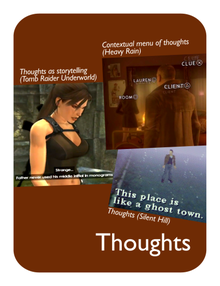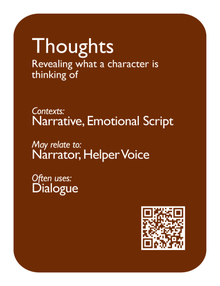Difference between revisions of "Thoughts"
ValterAlves (Talk | contribs) m |
ValterAlves (Talk | contribs) m |
||
| (33 intermediate revisions by the same user not shown) | |||
| Line 1: | Line 1: | ||
{{Card | {{Card | ||
| − | | notesontop= | + | | notesontop= introduced in version 2.0 of the [[Deck]]. |
| − | | | + | | deckversion=v20 |
| − | | | + | | name =Helper Voice |
| − | | | + | | v20frontface =Thoughts-front-v20.png |
| − | | description = [[Thoughts]] allow expressing messages in a diegetic way. | + | | v20backface =Thoughts-back-v20.png |
| + | | v20synopsis = Revealing what a character is thinking of | ||
| + | | patternpresentation = | ||
| + | | cardpresentation= | ||
| + | | screenshots= | ||
| + | | v20rel-tag1=Contexts:<br> | ||
| + | | v20rel1=[[Narrative]], [[Emotional Script]]<br> | ||
| + | | v20rel-tag2=May relate to:<br> | ||
| + | | v20rel2=[[Narrator]], [[Helper Voice]]<br> | ||
| + | | v20rel-tag3=Often uses:<br> | ||
| + | | v20rel3=[[Dialogue]]<br> | ||
| + | | description = [[Thoughts]] allow expressing messages in a diegetic way. From an emotional standpoint ([[Emotional Script]]), providing access to the PC's [[Thoughts]] also has the potential to enhance the empathy between the player and the PC. Additionally, the associated introspection contributes to inspire and maintain a sense of immersion in the experience. | ||
| − | [[Thoughts]] often consist of [[Dialogue]] that contributes to the [[Narrative]], though other solutions have been explored. When [[Dialogue]] is used, it can actually be spoken (though usually in a | + | [[Thoughts]] often consist of [[Dialogue]] that contributes to the [[Narrative]], though other solutions have been explored. When [[Dialogue]] is used, it can actually be spoken (though usually in a quieter tone, being directed to the self), or it can be represented as a verbalization "inside the head" of the character. Usually, the latter case uses some acoustic effect, especially when the distinction is relevant (for instance when other characters are present). |
| + | | examples= | ||
| + | | ex1=<mt p="Thoughts" g="Heavy Rain" w="{{R16by9W}}" h="{{R16by9H}}" i=2>Choosing [[Thoughts]] as part of the gameplay.</mt> | ||
| + | | ex2=<mt p="Thoughts" g="Tomb Raider Underworld" w="{{R16by9W}}" h="{{R16by9H}}">Lara's comment (to herself) helps interpreting and focusing on a relevant piece of the puzzle.</mt> | ||
| + | | ex3=<mt p="Thoughts" g="Silent Hill" w="{{R16by9W}}" h="{{RSHH}}">The question allows the player to perceive the PC's interest and own difficulty in understanding the sight.</mt> | ||
| + | | ex4=<mt p="Thoughts" g="MGS4" altg="Metal Gear Solid 4: Guns of the Patriots" w="{{R16by9W}}" h="{{R16by9H}}">An flashback (audio only). In this one, Snake recalls a scene from the former Metal Gear Solid 2.</mt> | ||
| + | | ex5=<mt p="Thoughts" g="Sam and Max" altg="Sam & Max 301: The Penal Zone" w="{{R4by3W}}" h="{{R4by3H}}">Reading (listening to) other's [[Thoughts]] as part of the gameplay.</mt> | ||
| + | | ex6=<mt p="Thoughts" g="Heavy Rain" w="{{R16by9W}}" h="{{R16by9H}}" i=3>PC's [[Thoughts]] as hints on how to proceed.</mt> | ||
| + | | ex7=<mt p="Thoughts" g="Deadly Premonition" w="{{R16by9W}}" h="{{R16by9H}}"></mt> | ||
| − | + | <!--| ex_=<mt p="Thoughts" g="SilentHillHomecoming" altg="Silent Hill Homecoming" w="{{R16by9W}}" h="{{R16by9H}}">The question augments the focus and suggests that there is something special about this particular scene.</mt>--> | |
| − | | | + | |
| − | + | ||
| − | + | ||
| − | + | ||
}} | }} | ||
Latest revision as of 16:47, 26 August 2012

|

| |
| The card's front face | The card's back face |
Contents
Synopsis
| Revealing what a character is thinking of. |
Relationships
Contexts:
Narrative ![]() , Emotional Script
, Emotional Script ![]() .
.
May relate to:
Narrator ![]() , Helper Voice
, Helper Voice ![]() .
.
Often uses:
Dialogue ![]() .
.
Description
Thoughts allow expressing messages in a diegetic way. From an emotional standpoint (Emotional Script), providing access to the PC's Thoughts also has the potential to enhance the empathy between the player and the PC. Additionally, the associated introspection contributes to inspire and maintain a sense of immersion in the experience.
Thoughts often consist of Dialogue that contributes to the Narrative, though other solutions have been explored. When Dialogue is used, it can actually be spoken (though usually in a quieter tone, being directed to the self), or it can be represented as a verbalization "inside the head" of the character. Usually, the latter case uses some acoustic effect, especially when the distinction is relevant (for instance when other characters are present).
Examples







